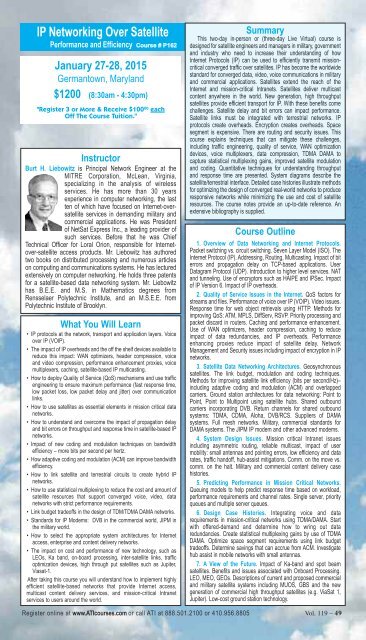Download - Applied Technology Institute
Download - Applied Technology Institute
Download - Applied Technology Institute
- No tags were found...
Create successful ePaper yourself
Turn your PDF publications into a flip-book with our unique Google optimized e-Paper software.
IP Networking Over SatellitePerformance and Efficiency Course # P162January 27-28, 2015Germantown, Maryland$1200 (8:30am - 4:30pm)"Register 3 or More & Receive $100 00 eachOff The Course Tuition."InstructorBurt H. Liebowitz is Principal Network Engineer at theMITRE Corporation, McLean, Virginia,specializing in the analysis of wirelessservices. He has more than 30 yearsexperience in computer networking, the lastten of which have focused on Internet-oversatelliteservices in demanding military andcommercial applications. He was Presidentof NetSat Express Inc., a leading provider ofsuch services. Before that he was ChiefTechnical Officer for Loral Orion, responsible for Internetover-satelliteaccess products. Mr. Liebowitz has authoredtwo books on distributed processing and numerous articleson computing and communications systems. He has lecturedextensively on computer networking. He holds three patentsfor a satellite-based data networking system. Mr. Liebowitzhas B.E.E. and M.S. in Mathematics degrees fromRensselaer Polytechnic <strong>Institute</strong>, and an M.S.E.E. fromPolytechnic <strong>Institute</strong> of Brooklyn.What You Will Learn• IP protocols at the network, transport and application layers. Voiceover IP (VOIP).• The impact of IP overheads and the off the shelf devices available toreduce this impact: WAN optimizers, header compression, voiceand video compression, performance enhancement proxies, voicemultiplexers, caching, satellite-based IP multicasting.• How to deploy Quality of Service (QoS) mechanisms and use trafficengineering to ensure maximum performance (fast response time,low packet loss, low packet delay and jitter) over communicationlinks.• How to use satellites as essential elements in mission critical datanetworks.• How to understand and overcome the impact of propagation delayand bit errors on throughput and response time in satellite-based IPnetworks.• Impact of new coding and modulation techniques on bandwidthefficiency – more bits per second per hertz.• How adaptive coding and modulation (ACM) can improve bandwidthefficiency.• How to link satellite and terrestrial circuits to create hybrid IPnetworks.• How to use statistical multiplexing to reduce the cost and amount ofsatellite resources that support converged voice, video, datanetworks with strict performance requirements.• Link budget tradeoffs in the design of TDM/TDMA DAMA networks.• Standards for IP Modems: DVB in the commercial world, JIPM inthe military world.• How to select the appropriate system architectures for Internetaccess, enterprise and content delivery networks.• The impact on cost and performance of new technology, such asLEOs, Ka band, on-board processing, inter-satellite links, trafficoptimization devices, high through put satellites such as Jupiter,Viasat-1.After taking this course you will understand how to implement highlyefficient satellite-based networks that provide Internet access,multicast content delivery services, and mission-critical Intranetservices to users around the world.SummaryThis two-day in-person or (three-day Live Virtual) course isdesigned for satellite engineers and managers in military, governmentand industry who need to increase their understanding of howInternet Protocols (IP) can be used to efficiently transmit missioncriticalconverged traffic over satellites. IP has become the worldwidestandard for converged data, video, voice communications in militaryand commercial applications. Satellites extend the reach of theInternet and mission-critical Intranets. Satellites deliver multicastcontent anywhere in the world. New generation, high throughputsatellites provide efficient transport for IP. With these benefits comechallenges. Satellite delay and bit errors can impact performance.Satellite links must be integrated with terrestrial networks. IPprotocols create overheads. Encryption creates overheads. Spacesegment is expensive. There are routing and security issues. Thiscourse explains techniques that can mitigate these challenges,including traffic engineering, quality of service, WAN optimizationdevices, voice multiplexers, data compression, TDMA DAMA tocapture statistical multiplexing gains, improved satellite modulationand coding. Quantitative techniques for understanding throughputand response time are presented. System diagrams describe thesatellite/terrestrial interface. Detailed case histories illustrate methodsfor optimizing the design of converged real-world networks to produceresponsive networks while minimizing the use and cost of satelliteresources. The course notes provide an up-to-date reference. Anextensive bibliography is supplied.Course Outline1. Overview of Data Networking and Internet Protocols.Packet switching vs. circuit switching. Seven Layer Model (ISO). TheInternet Protocol (IP). Addressing, Routing, Multicasting. Impact of biterrors and propagation delay on TCP-based applications. UserDatagram Protocol (UDP). Introduction to higher level services. NATand tunneling. Use of encryptors such as HAIPE and IPSec. Impactof IP Version 6. Impact of IP overheads.2. Quality of Service Issues in the Internet. QoS factors forstreams and files. Performance of voice over IP (VOIP). Video issues.Response time for web object retrievals using HTTP. Methods forimproving QoS: ATM, MPLS, DiffServ, RSVP. Priority processing andpacket discard in routers. Caching and performance enhancement.Use of WAN optimizers, header compression, caching to reduceimpact of data redundancies, and IP overheads. Performanceenhancing proxies reduce impact of satellite delay. NetworkManagement and Security issues including impact of encryption in IPnetworks.3. Satellite Data Networking Architectures. Geosynchronoussatellites. The link budget, modulation and coding techniques.Methods for improving satellite link efficiency (bits per second/Hz)–including adaptive coding and modulation (ACM) and overlappedcarriers. Ground station architectures for data networking: Point toPoint, Point to Multipoint using satellite hubs. Shared outboundcarriers incorporating DVB. Return channels for shared outboundsystems: TDMA, CDMA, Aloha, DVB/RCS. Suppliers of DAMAsystems. Full mesh networks. Military, commercial standards forDAMA systems. The JIPM IP modem and other advanced modems.4. System Design Issues. Mission critical Intranet issuesincluding asymmetric routing, reliable multicast, impact of usermobility: small antennas and pointing errors, low efficiency and datarates, traffic handoff, hub-assist mitigations. Comm. on the move vs.comm. on the halt. Military and commercial content delivery casehistories.5. Predicting Performance in Mission Critical Networks.Queuing models to help predict response time based on workload,performance requirements and channel rates. Single server, priorityqueues and multiple server queues.6. Design Case Histories. Integrating voice and datarequirements in mission-critical networks using TDMA/DAMA. Startwith offered-demand and determine how to wring out dataredundancies. Create statistical multiplexing gains by use of TDMADAMA. Optimize space segment requirements using link budgettradeoffs. Determine savings that can accrue from ACM. Investigatehub assist in mobile networks with small antennas.7. A View of the Future. Impact of Ka-band and spot beamsatellites. Benefits and issues associated with Onboard Processing.LEO, MEO, GEOs. Descriptions of current and proposed commercialand military satellite systems including MUOS, GBS and the newgeneration of commercial high throughput satellites (e.g. ViaSat 1,Jupiter). Low-cost ground station technology.Register online at www.ATIcourses.com or call ATI at 888.501.2100 or 410.956.8805 Vol. 119 – 49
















